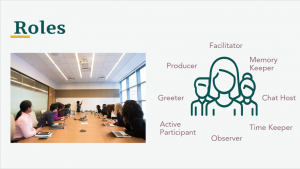Tips & Tricks for Digital Engagement
Connecting virtually has become a part of our new normal.
Zoom fatigue is real.
And, to add to that fatigue, many digital platforms have emerged, each with their own set of rules to master. Enter, Kalie McMonagle, Collaboration Manager with The Civic Canopy and a Mentor with Data Across Sector for Health's (DASH) Mentorship Program. McMonagle led a two-part series on How to (Meaningfully) Engage Remotely and shared some surprisingly easy ways to up your virtual engagement game.
The Canopy started offering this when they realized, "There were hundreds of resource lists and webinars circulating when the pandemic started, but very few opportunities for workshopping and troubleshooting tools. We wanted to create a space where people could practice and engage with tools for remote meetings," says McMonagle.
"When COVID-19 hit, some of our DASH awardees wondered how or if they would be able to continue their community engagement work in this new reality. We hoped to figure out how virtual techniques can supplement what we take for granted of in-person convenings, such as body language, face-to-face interaction, and even just connecting with the people around you. Kalie's approach with the Google Slides as a whiteboard seemed to tackle these concerns," says Susan Martinez, DASH Program Associate and workshop participant.
Here are a few highlights and lessons learned:
The first session focused on learning how to reimagine using existing tools, specifically, using Google Slides as a collaborative whiteboard. Examples that Kalie shared included using Google Slides to rank ideas, brainstorm challenges and voting on ideas. "It's as simple as creating shapes, fillable boxes, arrows and stickers and arranging them in a way you would a physical idea board," says Miriam Castro, DASH Program Manager and workshop participant. "The key is playing around with Google slide functionality and practicing," she says.
A key component to pulling off a truly engaging and collaborative meeting is having the right support. "Oftentimes," says McMonagle, "participants come into online meetings expecting to watch, not engage. Highlighting specific tasks for participants during a meeting gives them a sense of ownership of a meeting, like they would have in-person. It can also take a load of the facilitator to do everything."
"Through the course of transitioning from in person to going all virtual, our team learned pretty quickly that we needed more hands helping behind the scenes. We also learned that we needed to incorporate new roles and different types of supporting roles such as Chat Hosts and Greeters, to truly ensure that participants feel engaged," says Castro.
Kalie also shared best practices to consider in creating collaborative meetings which include a mix of activity strategy and a thorough understanding of the platform's functionality. For instance, Zoom's chat and breakout room features can be used to provide variety and a more hands-on approach during a meeting.
"The biggest takeaway for me was the utilization of tools like Google Whiteboard: these webinars illustrated how useful tools like that can be with keeping participants engaged and a part of the overall flow of remote meetings. These webinars illustrated that traditional face to face meetings can in many ways be achieved remotely if we're willing to step out of the box a little and embrace the many tools at our disposal," says Zeb Gantt, Community Research & Data Specialist United Way of Greenwood and Abbeville Counties, workshop participant and DASH mentee.
Part of the workshop included brainstorming ways to better understand how to make that transition from in person. Ideas that surfaced included: meetings to virtual meetings. The group discussed challenges and solutions for what worked for them and ideas to try in future meetings.
Using sticky notes
Moving around, joining breakout groups
Asking open-ended questions and encouraging people to share
Encouraging use of the Zoom stamps to indicate approval/disapproval of ideas
Using the Thumbs Up feature
Check out all the great ideas by accessing the collaborative white board from the first workshop.
When the group met again a week later, we spent time in breakout groups where we brainstormed such topics as how to build rapport in an online environment, troubleshooting access issues across multiple platforms and engaging participants remotely and facilitating networking. Check out the great ideas by accessing the collaborative white board from the second workshop.
"I support a peer group of state public health privacy professionals that meets virtually on a quarterly basis," says Sallie Milam, Deputy Director, the Network for Public Health Law, Mid-States Region and workshop participant. "Towards the end of each meeting, we offer attendees a slate of topics for the next webinar and ask them to identify what they would like to focus on next. I plan on using Google Slides as a whiteboard to create a place where everyone can rank ideas. Everyone will be able to see the white board and weigh in, if they choose. I'm excited that it will help support more engagement among the peer group along with a more efficient decision-making process."
Kalie shared her knowledge with 48 mentees over the two day workshop. View a recording of Remote Engagement:Tips & Tricks with the Civic Canopy using the access code: D@shM3ntee.



